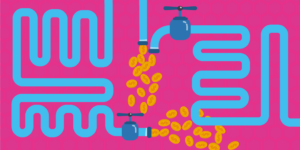Your cash flow is the total amount of money moving in and out of your business. At its most basic, the cash flow formula calculates what’s left over after you subtract all your expenses from all your revenues. If your business is successful, you should see more cash coming in (from clients buying your products and services) than cash going out (for expenses such as rent, office supplies, etc.). Let’s face it: Without cash coming in, you don’t have a business. But how can you tell if you’re on your way toward running out of cash? There are a few common signs to look out for that indicate a cash flow problem.
Understanding Cash Flow
What is Cash Flow and Its Importance
Cash flow refers to the movement of money into and out of your business over a specific period. Think of it as the lifeblood of your company, determining your ability to pay bills, invest in growth, and handle unexpected expenses. Positive cash flow means you have more money coming in than going out, which is a sign of financial health. On the flip side, negative cash flow indicates that your expenses are outpacing your income, leading to potential cash flow problems. Effective cash flow management is crucial for small business owners to make informed decisions, manage risks, and achieve long-term success.
The Risks of Negative Cash Flow
Negative cash flow can spell trouble for your business. It can lead to reduced liquidity, making it harder to cover day-to-day expenses. Increased debt and decreased profitability are other common consequences. Moreover, negative cash flow can limit your ability to invest in growth opportunities, respond to market changes, and maintain a competitive edge. It can also damage your credit score, making it more challenging to secure loans or attract investors. Therefore, it’s vital for business owners to keep a close eye on their cash flow and take proactive steps to address any cash flow problems that may arise.
Signs of Potential Cash Flow Problems
No Projected Negative Cash Flow
Every business should have a plan for revenues and profits. A cash flow statement, income statement, and balance sheet are three essential financial management tools for every business. It’s important to have an accurate cash flow projection that helps determine how much cash is available, how much cash is necessary for your daily operations and how much is required for non-income statement activities (such as investments in inventory, staff, infrastructure, software, etc.). You should also understand ways to improve cash flow, which we will get into later in this post.
Stagnant or Decreasing Sales
Your sales dollars coming into the business will ultimately be used to pay for any expenses. So if your sales are declining, it’s likely that you won’t be able to support your business in the long term. Perhaps the most concerning part of declining sales? It typically indicates that your product or service is no longer accepted or desired by your customer base. Think carefully about whether you should continue to pursue this business model or pivot to a new one.
Flat-lining Market Acceptance Indicators
“Market acceptance indicators” are metrics that help benchmark the status of your business. For example, you could track the renewal rate of your sales or the conversion rate of your leads. Many companies rely on repeat customers and revolving leads for sustainability — in other words, people who come back to you again and again. If these metrics start to flat-line or decline, you’ll start to run out of cash fast.
Rapid Business Growth
A business growing at a rapid pace is more likely to run out of cash than a business growing at a slower pace. The quicker your business grows, the stronger your need for an increase in cash flow. For example, say your business recently received an influx of work or a large order for products. To manage that demand, you need to hire employees, invest in additional software for efficiency or purchase tools and supplies to keep up. It’s smarter to try to control growth at a slower pace so you can manage cash flow and demand at all times.
Minimal Business History
If you just launched your business, you’re more likely to run into cash flow issues than if you were well-established. Businesses in an early stage of development are more prone to running out of cash due to poor cash flow management, simply because entrepreneurs often underestimate the cash flow required in their business and fail to accurately make a plan.
Common Cash Flow Problems
Over-financing and Underestimating Costs
Over-financing and underestimating costs are two common cash flow problems that can significantly impact your business. Over-financing happens when you take on too much debt to fund your operations, leading to high interest payments and reduced cash flow. On the other hand, underestimating costs can result in unexpected expenses that quickly deplete your cash reserves. To avoid these pitfalls, business owners should carefully manage their debt levels, create accurate financial projections, and regularly review their cash flow statements. This proactive approach can help identify potential issues before they become major problems, ensuring a healthier cash flow for your business.
How to Improve Your Cash Flow Management
As a small business owner, it’s crucial to implement strategies to improve your cash flow and stay out of the red.
So how can you avoid the situations above? Many business owners simply see growth as a solution to any cash flow issue. But as we mentioned above, rapid growth is also a sign that you could quickly run out of business cash. Below are a few strategies to help improve your cash flow and stay out of the red.
- Collect receivables: This may seem obvious, but if you can speed up the receipt of payments owed to you, it will help your cash flow. There may be ways you can help your customers, vendors, partners and suppliers pay you more quickly. For example, consider offering a discount for paying early.
- Enforce payment discipline: If you’re not getting paid promptly, include a payment policy in your vendor, supplier and customer contracts that states terms (e.g., when interest will set in if payment is not received). This could state that the total must be paid within 30 days, or it will accrue 1 percent interest daily until payment is received.
- Review suppliers and inventory: Frequently reviewing inventory will show you the costs and benefits of holding various items. For example, having too much of something could incur costs and lead to a cash flow deficit, while keeping too little could mean lost sales and a poor customer experience. This takes practice and constant revisions. Also, take a look at your suppliers. Is it possible you can find office suppliers cheaper, for example? Or can you offer a trade for goods/services?
- Generate new sales: Launch a campaign or promotion related to a specific service or product you’re trying to sell. Implement a discount (if you can swing it), or install a rewards program. Any of these techniques can help boost your sales.
- Reduce overhead: Do you have unnecessary equipment, software or vehicles that you’re paying for on a monthly or yearly basis? Consider leasing. Research the best deals on software or technology services and see if there’s a cumulative solution that cut down on costs.
How Do I Know if My Cash Flow Is in Good Shape?
Whether or not your business cash flow is under control can be determined by answering two questions:
- What is my cash balance right now?
- What do I expect my cash balance to be six months from now?
Below are a few ideas to help you confidently answer those questions.
- Budget for it: Continue to have conversations about the status of your current cash flow, projected needs for the business, outstanding cash outlays and ways to generate additional cash. Being aware of these key targets is a must to stay on top of your financials.
- Maintain cash reserves: As a business owner, if you end up needing cash, you’ll most likely have to pay a fee to get it (think quick loans or a line of credit). Plan ahead and secure sources of cash before they’re needed.
- Track it: Continuously monitor your cash flow results every month to determine if you’re generating the cash flow your business needs not just to survive, but grow. There are many ways to track your cash flow, including a simple spreadsheet or more robust financial software.
Running out of cash is one of the main reasons many businesses fail. Month after month, you need to be continually reviewing your cash coming in and cash going out. Acknowledging the above signals and implementing a strategy to control and improve your cash flow will strengthen your business. Know of other signs and solutions that can help keep your business cash flow positive? Let us know on Twitter @Finance Logix_com.




















